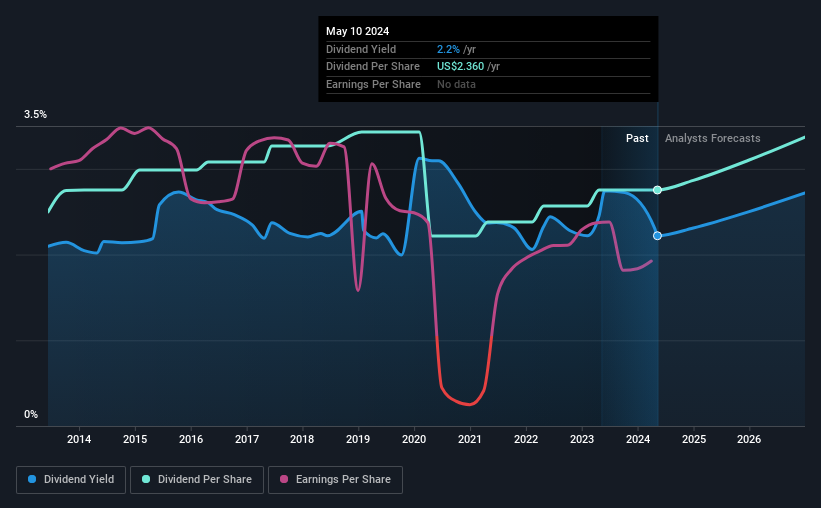RTX Corporation (NYSE:RTX) Pays A US$0.63 Dividend In Just Four Days
Regular readers will know that we love our dividends at Simply Wall St, which is why it's exciting to see RTX Corporation (NYSE:RTX) is about to trade ex-dividend in the next 4 days. The ex-dividend date is one business day before the record date, which is the cut-off date for shareholders to be present on the company's books to be eligible for a dividend payment. It is important to be aware of the ex-dividend date because any trade on the stock needs to have been settled on or before the record date. This means that investors who purchase RTX's shares on or after the 16th of May will not receive the dividend, which will be paid on the 13th of June.
The company's next dividend payment will be US$0.63 per share. Last year, in total, the company distributed US$2.36 to shareholders. Based on the last year's worth of payments, RTX stock has a trailing yield of around 2.2% on the current share price of US$106.32. If you buy this business for its dividend, you should have an idea of whether RTX's dividend is reliable and sustainable. So we need to investigate whether RTX can afford its dividend, and if the dividend could grow.
View our latest analysis for RTX
Dividends are typically paid from company earnings. If a company pays more in dividends than it earned in profit, then the dividend could be unsustainable. Last year RTX paid out 95% of its profits as dividends to shareholders, suggesting the dividend is not well covered by earnings. That said, even highly profitable companies sometimes might not generate enough cash to pay the dividend, which is why we should always check if the dividend is covered by cash flow. Over the last year it paid out 54% of its free cash flow as dividends, within the usual range for most companies.
It's good to see that while RTX's dividends were not well covered by profits, at least they are affordable from a cash perspective. Still, if the company continues paying out such a high percentage of its profits, the dividend could be at risk if business turns sour.
Click here to see the company's payout ratio, plus analyst estimates of its future dividends.
Have Earnings And Dividends Been Growing?
Companies with consistently growing earnings per share generally make the best dividend stocks, as they usually find it easier to grow dividends per share. If earnings decline and the company is forced to cut its dividend, investors could watch the value of their investment go up in smoke. For this reason, we're glad to see RTX's earnings per share have risen 12% per annum over the last five years.
Another key way to measure a company's dividend prospects is by measuring its historical rate of dividend growth. RTX has delivered 1.0% dividend growth per year on average over the past 10 years. Earnings per share have been growing much quicker than dividends, potentially because RTX is keeping back more of its profits to grow the business.
To Sum It Up
Should investors buy RTX for the upcoming dividend? Growing earnings per share and a normal cashflow payout ratio is an ok combination, but we're concerned that the company is paying out such a high percentage of its income as dividends. In summary, while it has some positive characteristics, we're not inclined to race out and buy RTX today.
So if you want to do more digging on RTX, you'll find it worthwhile knowing the risks that this stock faces. For example, we've found 4 warning signs for RTX that we recommend you consider before investing in the business.
Generally, we wouldn't recommend just buying the first dividend stock you see. Here's a curated list of interesting stocks that are strong dividend payers.
Have feedback on this article? Concerned about the content? Get in touch with us directly. Alternatively, email editorial-team (at) simplywallst.com.
This article by Simply Wall St is general in nature. We provide commentary based on historical data and analyst forecasts only using an unbiased methodology and our articles are not intended to be financial advice. It does not constitute a recommendation to buy or sell any stock, and does not take account of your objectives, or your financial situation. We aim to bring you long-term focused analysis driven by fundamental data. Note that our analysis may not factor in the latest price-sensitive company announcements or qualitative material. Simply Wall St has no position in any stocks mentioned.

 Yahoo Finance
Yahoo Finance 
